Vol 6 No. 3 TROPIC LIGHTNING NEWS February 8, 1971
Index
| Unit Page | Unit Page | Unit Page | Unit Page |
| 1/5 3 | 2/12 3 | 3/22 Photo 8 | 75th Ranger Photo 1 |
| 1/8 Arty 8 | 3/22 3 | 3/4 Cav 1 | 75th Ranger Photo 3 |
| 1/8 Arty Photo 8 | 3/22 4 | 65th Engr 4 | 75th Ranger Photos 7 |
| 1/27 3 | 3/22 8 | 75th Ranger 1 | Cambodia Refugees 2 |
| 1/27 8 |
‘ALL THE WAY’
By SP4 TRUMAN KAPUT
FRENZELL-JONES - “RAIN-JAH”... “HAIR-BOHNE”... “HAAAAA!!!!!”
Remember that from basic training? And everybody visualized a
bunch of fanatical Marine-types who would go out of their way to step on an ant.
Well, here at F-J, one needs only to walk or drive by the brightly
painted black and yellow barracks near the snack bar to find the 25th
Division’s representatives of this elite guard.
The 75th Infantry’s Company F (RANGER) troopers are all
volunteers and proud of it. They take pride not only in their performance
but in themselves and their unit as well. From their black berets to their
well-shined boots they are STRAC-all the way.
But for all of the sharpness of appearance, it is the high degree
of professionalism in battle that is of the utmost importance to each man.
Whether it’s on a reconnaissance or ambush mission, the Rangers
PERFORM. Working in highly-trained six-man teams and utilizing their
Vietnamese scout or a combat tracker, finding signs of the enemy’s presence is
their thing. After detection comes the insertion of a contact-seeking
team.
“We carry as much weaponry and ammo on an ambush patrol as a line
unit platoon,” said Staff Sergeant Mike Hochrein of Dubois, Penn.
Hochrein is a team leader whose six men have accounted for five enemy kills in
the past two months.
Backing up the small-sized teams are the helicopter gunships of the
3rd Squadron, 4th Cavalry’s Delta Troop.
“‘Centaur’ firepower has helped many teams out of trouble and
so we have a very close relationship with the men over there,” stated CPT Jay
Hickey of Ocoee, Fla., the Ranger CO.
Working in dense jungle necessitates some exceptional
skills on the part of each man - especially in the area of first-aid.
“Not only being able to administer the four life-saving steps to
a wounded man but also to be able to give an intravenous transfusion when a
medevac can’t land is part of my job,” explained Private First Class Timothy
Hunter of Rhinelander, Wis., a Ranger medic.
Of the 60-odd Rangers, about half are on jump status and draw the
extra jump pay of $55 a month. 26 are Ranger School graduates, and 29 have
been through Recondo School.
When asked to explain his men’s approach to the Army and to life,
Captain Hickey points to a sign in front of the Rangers’ headquarters:
“It is not the critic who counts, not the man who points out how
the strong man stumbled or where the doer of deeds could have done better.
The credit actually belongs to the man who is actually in the arena, whose face
is marred by dust, sweat and blood; who knows great enthusiasm: great devotion,
the triumph of high achievement and who, at the worst, if he fails, fails while
daring greatly; that his place shall never be with those cold and timid souls
who know neither victory or defeat. For those who have had to fight for
it, life truly has a flavor the protected shall never know.”
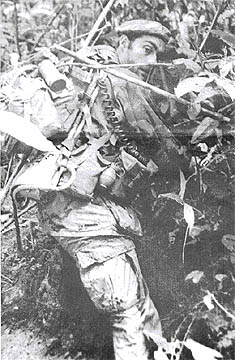 |
RANGER ON THE MOVE - Team Leader Staff Sergeant Nicholes J. Demongeot of Osseo, Mich., a member of Company F, 75th Infantry (Rangers) moves through the jungle southwest of Xuan Loc. (Photo by SP4 Joseph Kelly, II FFV) |
Page 2 TROPIC LIGHTNING NEWS February 8, 1971
GIs Get Tax Break
By SGT RICHARD CONNELL
Camp Frenzell-Jones - Along with the annual hangover and
resolutions, the new year ushers in thoughts of Income Tax. Don’t frown
yet however, serving in the armed forces in a combat zone affords you benefits
not offered your counterparts back in the States.
According to the Internal Revenue Service (IRS), a member of the
armed forces serving in a combat zone or hospitalized as a result of wounds,
disease, or injuries incurred in a combat zone is exempt from income tax
withholding and is omitted from Wage and Tax statements. The only catch is
that you have to be a warrant officer or enlisted man. The exemption
applies only to the first $500.00 of the monthly pay of commissioned officers.
So you don’t have to pay income tax while in Vietnam, but what
about when you return to the World? Again the IRS has given the serviceman
a break. According to Section 7508 of the Internal Revenue Code,
“members of the armed forces who served in a combat zone have an additional
180 days from the time they depart Vietnam in which to file their income tax
return.”
It is important however, to file your return BEFORE the 180-day
extension period expires and attach a statement to your form showing when you
served in Vietnam. Such a statement might read as follows: “I, (your
name), was on duty in Vietnam from (give your arrival date) until (give your
DEROS date). My postponed Income Tax filing date is (180 days later).”
If you’re married and file a joint return with your wife there
are several options open to you. The first is to file jointly after your return.
This can be done even though your wife may be working presently. Your wife
may also file a joint return but exclude your name and write in “In military
Service in Vietnam” in the space provided. Finally, if you file separate
returns, your wife can go ahead and file separately and you can do the same
thing when you return.
More good news is that you may be eligible for $30.00 a month
“separation pay.” The extra allowance is for being separated from your
wife and dependents. Check with your Personnel Services NCO about income
tax and separation pay.
 |
| MOST WILL BE FARMERS - Suoi Cat settlers prepare a plot of land for a vegetable garden. The settlement’s 450 families are all from the Cambodian capital city of Phnom Penh, and have had no agricultural experience. |
Refugees Settle At Soui Cat
By 1LT RICHARD HARRIS
SUOI CAT - In Phnom Penh, Tran Van Biot was a truck driver, and his
wife a domestic for a French family. Now, ten months after the massacres
which drove the ethnic Vietnamese from Cambodia, Tran and his family are
starting new lives as farmers in eastern Long Khanh province.
Last spring the Cambodians, frightened and enraged by the coming of
war to their country, turned upon the ethnic Vietnamese minority in the country,
killing thousands and leaving other thousands homeless.
Tran and his family were among the lucky to escape the
Cambodians’ rage with their lives, and with 200,000 others, have been
relocated in Vietnam in rural settlements.
Suoi Cat, where Tran has settled with 450 other refugee families,
is one of seven Cambodian refugee villages in Long Khanh province, with a total
population of around 7,000.
Located at the base of Signal Mountain east of Xuan Loc on Highway
One, Suoi Cat is the home of 2200 refugees from Phnom Penh, the Cambodian
capital. The settlement is virtually 100 percent Catholic, and is led by
Father Ho Quang Luat who is both the spiritual and temporal leader.
Father Luat recalls the happenings of last Spring with horror.
Speaking in fluent French, the Father recounts the evening of March 12: “In 20
minutes they had completely destroyed my house and church.. They were
killing our young people and destroying our home... there was much fear...”
Survivors of the massacres were held in “concentration camps”
until the end of July, when they were boarded onto refugee ships and brought to
Vietnam.
In September, Father Luat’s people were given the land at Suoi
Cat. The now-forested land will be cultivated for rice, with each family
having its own parcel. The fields will be irrigated by a stream which runs
through the forest.
The people also want to clear the forest for security reasons - the
woods come right up to the berm line, and afford the Viet Cong excellent cover
for attacks on the settlement. On December 22, a VC mortar attack killed
seven and wounded others - the accompanying ground attack was repelled.
There are now 100 young men in the self-defense force, manning
positions along the berm every night under the supervision of a nearby Popular
Force company. They have also been given rifles - the first time that
these people have ever borne arms.
Because of their urban background, the settlers of Suoi Cat will
have some problems in adjusting to their new life. In Phnom Penh, the men
were artisans and laborers and the women were domestics and cooks. None of
the families had ever done any farming, and at Suoi Cat all but a few will have
to make their living from the soil.
The Cambodia Vietnamese are not the first refugees to find a home
in Long Khanh province. After the partition of Vietnam in the mid-50s,
groups of Catholic anti-communist refugees from the Hanoi area settled in Long
Khanh, and today their villages are prospering throughout the province.
The first humble signs of “prosperity” have recently begun to
appear at Suoi Cat - early in January, the first cucumbers from village gardens
were sold in the community market.
The TROPIC LIGHTNING NEWS is an authorized publication of the 25th Infantry Division. It is published weekly for all division units in the Republic of Vietnam by the Information Office, 25th Infantry Division, APO San Francisco 96225. American Forces Press Service and Army News Feature materials are used. Views and opinions expressed are not necessarily those of the Department of the Army. Printed in Tokyo, Japan, by Pacific Stars and Stripes.
COL Joseph R. Ulatoski . . . . Commanding Officer
1LT F.E. Herron . . . . . . . . . . . Information Officer
1LT Richard Harris . . . . . . . . Officer-in-Charge
SP4 Scott A. Watson . . . . . . Editor
SP4 Michael J. Winston . . . Assistant Editor
SP4 Todd A. Weber . . . . . . . Senior Photographer
BATTALION CORRESPONDENTS
| SGT Bob Lodi SP4 John Corbin SP4 John Beres SP4 Willie Morris |
1/5 1/5 3/22 CSS |
SP4 Gary Burch PFC Ray Cassidy PFC Richard Haley SP4 Jim Schmidt |
65th Eng 2/12 1/8 1/27 |
Page 3 TROPIC LIGHTNING NEWS February 8, 1971
Brigade Summary
LONG KHANH-PHUOC TUY PROVINCES -- Units of the 2nd Brigade,
25th Infantry Division eliminated more than 20 enemy and more than 200 bunkers
during a recent three-week period in this area.
Elements of the 2nd Battalion 12th Infantry, the 1st Battalion 27th
Infantry, 1st Battalion (Mech) 5th Infantry and the 3rd Battalion 22nd Infantry
were the major contributors to the enemy’s damages.
2nd Bn, 12th Inf.
Bravo Company 2nd Battalion 12th Infantry operating northeast of
Fire Support Base Barbara on the second day of the period, discovered an enemy
base camp training area consisting of eight bunkers, three cooking hootches and
some benches and blackboards.
A half hour later the same Warriors unit located a similar
encampment, this one comprising about 18 bunkers.
The next day, in the same general area, another Bravo element found
a third enemy complex. This one had six underground structures housing a
typewriter, a sewing machine, and several other odd items.
Several days later, east of Barbara Bravo men uncovered a
camouflaged complex of 35 bunkers and seven fighting positions. There were
also some scattered AK rounds in one of the dug-outs.
A nine-bunker complex was added to the Bravo total four days later
back northeast of Barbara. Alfa Warriors jammed their finds into a
four-day period, uncovering three separate bunker complexes.
The first was found northeast of Barbara. Seven structures
and eight fighting positions, along with some dishes and pottery were discovered
at first. A wide search of the area located six more bunkers and a tunnel
system about 150 yards away.
The next day the Alfa troops located and destroyed 10 more bunkers
in one spot and, two hours later, added eight more. Eight others were
eliminated by Alfa two days later to complete the Company’s score.
| “SUPERWOP” - Ranger pointman Sp4 Frank Dalbo of Boundbrook, N. J., checks a VC fighting position discovered during a recent mission. | 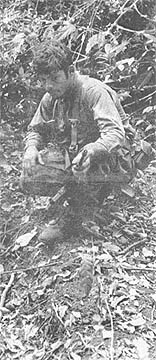 |
3rd Bn, 22nd Inf.
Charley Co. 3rd Battalion 22d Infantry Regulars had the largest
single contact of the period. Five VC were killed by a Regulars’
mechanical ambush detonated northwest of FSB Schwartz. Also collected in
the action were 11 rucksacks, assorted eating utensils, medical supplies, 175
pounds of rice and some food stuffs and other sundries.
A week earlier, in the same area, Charley Regs scored heavily
again. In a noontime engagement the GIs killed two NVA with small arms
fire. In the same action, the men captured one AK-50, one PPS-43 sub
machine gun.
Earlier that day another group of Regs found seven more bunkers in
a complex which had yielded 15 others the day before.
The big prize for Charley Co., however, occurred a week before
this, north of Schwartz.
“It looked like a VC department store,” recalled Specialist 4
Godfrey Arthur of Moses, Utah.
Amongst the 18-bunker complex the men collected dishes, pots, pans,
a kerosene lamp, Ho Chi Minh sandals, NVA boots, clothing, shovels, assorted AK
ammunition, NVA ponchos, tripwire detonators, U.S. grenades, canteens, foot
powder and flash light batteries.
And to top it all off, 20 more bunkers were located nearby.
| IT’S BEEN A HARD DAY’S FIGHT -- A mid-afternoon break gives a Second Brigade troop a moment to rest his legs and think of home. |  |
1st Bn (M) 5th Inf.
Bravo troops 1st Battalion 5th Infantry (Mech) surprised a group of
VC at chow time about 12 miles north of Xuan Loc. Amid a base camp with
its cooking fires still going, the Bobcats counted up 1800 M-16 rounds, 10 M-16
magazines, some claymore wire, ponchos, and other scattered ammunition.
Two days later the Bravos polished off their activities with a
night contact.
Reacting to a trip flare set off by some unsuspecting VC, the
Mechmen poured small arms fire into the area, which was followed by automatic
weapons action. Gunship fire power was also called in for good measure.
The enemy managed to return fire sporadically but in vain. Two NVA died as
a result of the action and two who were badly wounded and captured were taken to
a U.S. hospital for treatment. Two AKs, an RPG launcher and an RPG round
were confiscated.
 |
THE DOG SQUAD -- Tracker Sp4 Raymond Labuda, dog handler Sp4 Glenn Bristol, and scout dog “Willy” lead Second Brigade troops on a Charley hunt. |
1st Bn, 27th Inf.
Charley Company 1st Battalion 27th Infantry Wolfhounds accounted
for eight enemy dead in three separate reports near FSB Beverly.
An early morning mechanical ambush killed three Viet Cong
(Vietnamese Communist (VC)) west of Beverly. Confiscated in the action
were two AK-47s and a K-54.
Later that day other ‘Hounds of Charley Co. engaged an enemy
group northwest of Beverly. Artillery and helicopter gunships helped the
GIs to overwhelm the Communists, and resulting in two enemy dead, with no US
casualties.
A week later, in the same general area, Charley Co. elements
located a fresh grave containing three dead VC.
The Recon platoon of Echo Company also scored high over a four day
span, killing four enemy and destroying 14 bunkers in six actions.
Working northwest of Beverly, the Recon ‘Hounds followed up a
mechanical ambush detonation with small arms fire and brought down one VC dead.
Later in the afternoon, they encountered a group of about five
enemy hidden in a bunker complex. After determining that the Communist
troops were well entrenched, artillery was called in. A subsequent sweep
turned up one dead VC.
The next day the Recon force intercepted a squad of VC moving along
a trail. After a brief volley of small arms fire the men took out after
the fleeing soldiers.
During the next day’s activities the Recons found two
seven-bunker complexes and destroyed them.
Page 4-5 TROPIC LIGHTNING NEWS February 8, 1971
 |
| FINISHED PRODUCT – A chopper takes off from the new landing zone; the result of the Engineer’s labors. (Photo by SP4 Gary Burch) |
Engineers Clear LZ
By SGT GARY BURCH
LEOPARD MAIN - Two squads of 65th Engineer Company’s second
platoon, supported by a platoon of 3rd Battalion 22nd Infantry “Regulars”
cleared a landing zone north of here on a recent three-day mission.
The first step in preparing the LZ was taken by the Air Force when
they dropped a 15,000 pound bomb in the middle of the dense jungle.
The big bomb, known as a “commando vault” or “daisy
cutter,” is especially designed for knocking down trees.
Most of the big trees in an 85 meter diameter were blown away by
the bomb, and it was the engineers’ job to clear the debris and those hardy
trees which survived the blast. Staff Sergeant Daniel “Chicken Man”
Dearborn’s first squad prepared the overall demolition plan and specific
charges, while SSG William “Big Daddy” Proctor, of Middletown, Pa., directed
his men in felling the remaining trees with axes and chainsaws.
Several bunkers were discovered while clearing the area, as well as
a fighting trench, two booby traps, a bat (not the baseball kind,) and two
bamboo vipers. The booby traps - a 155 round and a 75 round - were laying
under some shattered brush with a trip wire still attached to the 155.
A large part of the demolition work was carried out by Specialist 4
Fred Gebhart of Chilton, Wis., who destroyed the bunkers by placing a charge in
each wall and on the main roof beams. A liberal application of persistent CS
will further lessen the chance of Charley returning to his old home.
| BOOM! – An explosive charge does a job on yet another tree. (Photo by SP4 Gary Burch) |
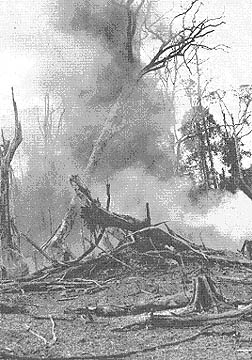 |
 |
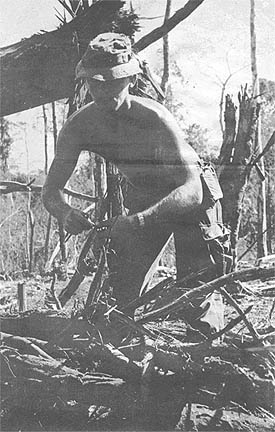 |
| WITH SAW IN HAND – Specialist 4 Julius “Booker T” Grant of Hubbard, Ohio, takes a moments rest before attacking another tree. (Photo by SP4 Gary Burch) | SETTING A CHARGE – Sergeant Robert Mitcheltree of Sharpsville, Pa., sets a charge under a pile of debris that has to be removed. (Photo by SP4 Gary Burch) |
| SAVAGES – L to R Kenneth Renke, Billy Johnson and Dennis Gillard deliver the coup de grace to one more tree as Cephus Phillips looks on.. (Photo by SP4 Gary Burch) |
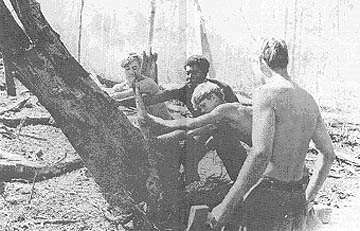 |
Page 6 TROPIC LIGHTNING NEWS February 8, 1971
 GENERAL BOB HOPE REPORTING - No sooner did Bob Hope get off
his plane in the states then he started spouting about how high the morale of
the GIs in Vietnam is and how all of us want victory - as well as peace.
Well Bob, in my humble opinion, the GIs may be high all right, but it certainly
hasn’t got anything to do with morale!
GENERAL BOB HOPE REPORTING - No sooner did Bob Hope get off
his plane in the states then he started spouting about how high the morale of
the GIs in Vietnam is and how all of us want victory - as well as peace.
Well Bob, in my humble opinion, the GIs may be high all right, but it certainly
hasn’t got anything to do with morale!
RAIN RAIN, GO AWAY - And it sure has!! Pretty soon, Camp F-J will take its
place beside the other great deserts of the world - the Sahara, the Mojavo and
the Gobi. (Cough, cough...)
A J-O-B WELL DONE DEPT. -- We’d like to take this opportunity to say a
grateful “thank you” to the men of the MARS station here. For months
we had to be content with the hit-or-miss operation at Cu Chi. But since
coming here its been a delight rather than the previous hassle to get a call
through to the folks at home. The guys up there “really have their ....
together.”
BULLETIN!! BULLETIN!!! Air Force Colonel indicted on marijuana
charge. You’d think those AF officers are high enough without having to
resort to ground-type trips.
WOLFHOUND SEAFOOD - Care for a gourmets’ delight? King crab??
Well, you can get all the crabs you want these days at the HQ of the 1st
Wolfhounds at F-J. Just ask any Hound in the area and he’ll gladly point
you in the right direction.
WAR IS HELL DEPT. - You can tell the war is really getting bad these days
whenever you travel Highway I to Xuan Loc. Any person with a degree of
common sense, in driving through a zone where there is dense woods to either
side, drives his jeep as fast as he can (a moving target is harder to hit the
faster it goes--right?). Unfortunately, though, some people can’t
understand such logic. These people would rather pull you over and give
you a ticket (and later an Article 15) in order to straighten you out.
Meanwhile old Nguyen Charlie just laughs and loads.
CORNY AND PUDGY?? - How can you burn creamed corn? Just ask the HHC mess
staff. They’ve found a way!
X-RATED MOVIES ARE A NO NO, BUT ... Although the military does a superlative job
in cutting out the heavy skin shots in the movies they allow us to see, they
don’t seem to bother with the censorship of certain local talent displays.
At a recent officer’s club spectacular, lovely oriental “dancer” Diana
Quick-Change performed what many agreed was not only an X performance, but also
a Y and a Z as she “left nothing to the imagination.” Come to think
about it, performing before such a homogenous grouping, I guess she figured
she’d better leave nothing to THEIR imaginations!
WHAT’S THE USE? - Did you hear recently where the U.S. Government is new
making AK rounds for use in Indochina? The reason given: the Cambodian
Army uses AK rifles. We just have to wonder how many of the U.S. made AK
rounds will find their way into RVN...and into whose rifles?
CAMP FRESNO-JONES??? - It seems as though the affliction that was plaguing the
75th Rangers has now spread to the local APO staff. That is, how to spell
words correctly on signs which everyone reads. The Rangers used to spell
communism “comunisum.” But that’s not nearly as bad as spelling
Frenzell “FrenSell!! No wonder those guys have a tough time distributing
the mail.
ATTENTION SNACK FREAKS - Reality House, a 14-bed drying-out center, was opened
recently on Frenzell-Jones. A staff of five counselors, including two
ex-addicts, is on hand to help people kick their habits. So if you think
it might be a good idea to quit your habit before you go back to the world,
here’s your chance .. .
Page 7 TROPIC LIGHTNING NEWS February 8, 1971
RANGERS
| UP GOES THE RADIO - Team Leader Staff Sergeant Nicholes J. Demongeot from Osseo, Mich., and Specialist 4 Brunette Lenord from Superior, Wis., set up a field expedient radio antenna in thick jungle southwest of Xuan Loc. (Photo by SP4 Joseph Kelly, II FFV) | 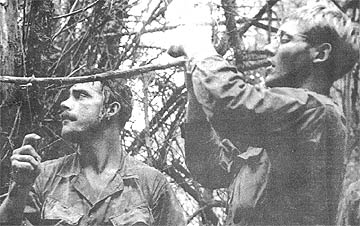 |
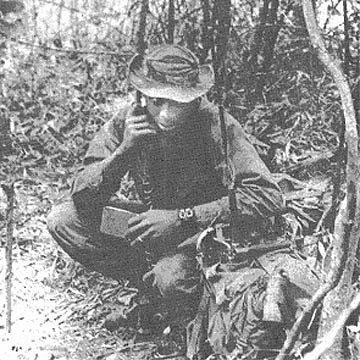 |
CALL - Specialist 4 Mayo McClinton from Md. requests further instruction as operation continues southwest of Xuan Loc. (Photo by SP4 Joseph Kelly, 11 FFV) |
| TIRED - PFC Edward C. Sellers Jr. of Memphis, Tenn., returns from an observation post, tired and weary. (Photo by SP4 Joseph Kelly, II FFV) |  |
Page 8 TROPIC LIGHTNING NEWS February 8, 1971
Delta Redlegs Lower the Boom On Three Enemy
The Redlegs of Delta Battery, 1st Battalion 8th Field Artillery
were credited with three VC killed when they fired support for a recon patrol
January 8th.
The action took place about 5 clicks northwest of Delta Battery’s
location, Fire Support Base Beverely.
The skirmish was initiated when a recon patrol of the 1st Battalion
27th Infantry (Wolfhounds) rounded a curve in the trail they were walking on and
came face to face with a group of eight VC walking down the trail. The
patrol immediately opened up on the VC with their M-16 ‘s and M-79’s. Within
minutes they had radioed in their location and asked for artillery support.
Delta Battery 1st of the 8th responded and dropped a total of 40 HE 105 howitzer
rounds in on the enemies location.
Captain Sidney G. Herndon, 1/8 liason officer explained, “The
artillery rounds started a fire and the recon patrol was not able to search the
area until the following morning. When they did recon the area they found
no trace of the VC. But a few days later C Company 1/27 uncovered a grave
in almost the same location that the recon patrol had ran into the VC. The
grave contained three bodies, and Delta Battery was given credit for all three
kills.”
Delta Battery, commanded by Captain John Mitchell, was formerly
Bravo Battery 2d Battalion 77th Artillery. However, they were transferred
to the Automatic Eighth when the 2/77th pulled out of Vietnam.
On January 16 Bravo Battery had a busy night firing 449 rounds for
a contact mission and having to unload chinooks that flew in ammo to them.
In other recent activity within the Battalion, Alfa Battery, at
fire Support Base Custer in the Sparrow Valley region, had a brush fire that
resulted in contact with the enemy. The fire, started by parachute flares,
threatened to burn a grove of banana trees. To prevent the destruction of
the banana tress, six men were sent out to extinguish the fire. To get to
the fire they had to cross a small ravine. In the ravine the men came into
contact with an estimated ten to twelve VC. They engaged the VC with their
M-16’s and made a hasty retreat to the berm.
 |
| THUNDER AT THE BREAK OF DAY - Further artillery support is given to those in the field by an eight incher from Two Field Force. |
Regulars’ Four Deuce - Men of Many Talents
By PFC JOHN BERES
LEOPARD MAIN - Every “leg” company in Republic of Vietnam has
its four deuce (4.2in) mortar platoon. The Division’s 3rd Battalion,
22nd Infantry, are fortunate to have an excellent one.
Four deuce’s contribution to the “Regulars” mission can be
exemplified in one word, versatility.
The primary mission of any four deuce platoon is to provide
indirect fire support for friendly units in the field. The four deuce
fires a round which is equivalent in size and bursting radius to an artillery
105 round.
When not performing their primary mission of firing and maintaining
their guns, four deuce acts as a labor force to provide many varied services.
Being one of the largest platoons in the Battalion, they have been
called upon to provide the bulk of the men for the dreaded work details.
As Specialist 4 John P Jones from Jacksonville, Fla. says, “They should change
our MOS to 11-D-10 for combat detail man or 11-SB-10 for combat sand bagger.
They don’t have enough MOSs to cover our work.”
The four deuce people have been known to pull ambush patrols, to
provide the security for the MEDCAPs, and make mine sweeps. They are also
utilized for base camp security. They put out mechanical ambushes, are
responsible to guard about a quarter of the perimeter, and stand by their guns
on 24 hour call.
| THE SOUND OF FIREPOWER -- Members of the 3rd Battalion 22nd Infantry mortar platoon cover their ears from the blast as they send off another four deuce (4.2inch) mortar. |
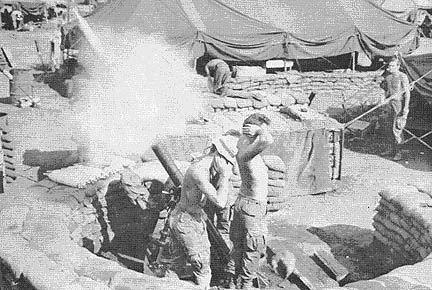 |
Thanks to
John Barrett, 3rd Bn., 22nd Inf. for sharing this issue,
Kirk Ramsey, 2nd Bn., 14th Inf. for creating this page.
This page last modified 9-18-2004
©2004 25th Infantry Division Association. All rights reserved.